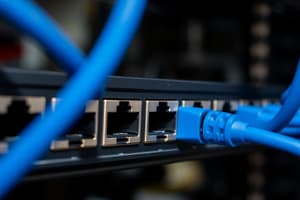Podcast
Questions and Answers
What is one primary benefit of using Software-Defined Networking (SDN) in an enterprise network?
What is one primary benefit of using Software-Defined Networking (SDN) in an enterprise network?
- It allows for remote management and configuration of network devices. (correct)
- It eliminates the need for any hardware components.
- It limits the types of devices that can be connected to the network.
- It requires all changes to be made manually by the administrator.
How does SDN help in monitoring network performance?
How does SDN help in monitoring network performance?
- By removing the need for any configuration at all.
- By automatically installing new hardware.
- By allowing real-time remote monitoring and problem resolution. (correct)
- By restricting access to only wired connections.
What is the primary purpose of a wireless access point in a network?
What is the primary purpose of a wireless access point in a network?
- To manage data flow between client devices
- To allow wireless devices to connect to the network (correct)
- To serve as the main router for external traffic
- To increase the speed of wired connections
What is the role of a patch panel in a network setup?
What is the role of a patch panel in a network setup?
What distinct function does a router serve in a network?
What distinct function does a router serve in a network?
Which statement about hubs is accurate?
Which statement about hubs is accurate?
Which of the following best describes Power over Ethernet (PoE)?
Which of the following best describes Power over Ethernet (PoE)?
Why might most networks still rely on wired connections despite advances in wireless technology?
Why might most networks still rely on wired connections despite advances in wireless technology?
How does a network switch differ from a hub?
How does a network switch differ from a hub?
When connecting a client device to a network, where does the Ethernet cable behind the wall port typically lead to?
When connecting a client device to a network, where does the Ethernet cable behind the wall port typically lead to?
What is the primary function of a network switch?
What is the primary function of a network switch?
What is a characteristic of unmanaged switches?
What is a characteristic of unmanaged switches?
What is the main purpose of a firewall in a network?
What is the main purpose of a firewall in a network?
How does a managed switch differ from an unmanaged switch?
How does a managed switch differ from an unmanaged switch?
What is the purpose of a PoE injector?
What is the purpose of a PoE injector?
Which PoE standard was the first to be released and is also known as Type 1 PoE?
Which PoE standard was the first to be released and is also known as Type 1 PoE?
What do VLANs provide in a network environment?
What do VLANs provide in a network environment?
What is one potential issue with passive PoE injectors?
What is one potential issue with passive PoE injectors?
Which of the following describes Type 4 PoE?
Which of the following describes Type 4 PoE?
What is a crucial factor to understand when using a PoE switch?
What is a crucial factor to understand when using a PoE switch?
How can a network firewall enhance security in a network?
How can a network firewall enhance security in a network?
Study Notes
Network Hardware
- Patch Panel: Houses termination points for ethernet cables, simplifying device relocation.
- Router: Connects networks together, forwarding traffic leaving the internal network.
- Hub: Older device that broadcasts data to all connected devices, leading to network inefficiencies and security risks.
- Switch: Forwards data only to the intended device using MAC addresses, improving efficiency and security.
- Managed Switch: Allows advanced configuration options for bigger networks, including VLANs, QoS, and traffic monitoring.
- Firewall: Monitors and blocks unauthorized network traffic, improving security.
Power over Ethernet (PoE)
- PoE uses existing Ethernet cables to power devices by using spare wires.
- Standards: IEEE 802.3 defines several PoE standards, each offering different power levels and using specific wire pairs.
- Type 1 PoE (802.3af): Provides up to 15.4 watts, suitable for low-power devices.
- Type 2 PoE (802.3at): Provides up to 30 watts, compatible with Type 1 devices and suitable for mid-power devices.
- Type 3 PoE (802.3bt): Provides up to 60 watts, suitable for mid-range devices like webcams.
- Type 4 PoE (802.3bt): Provides up to 100 watts, suitable for demanding devices like laptops or TVs.
- PoE Injector: Allows powering devices over Ethernet even if the switch doesn't support PoE.
- Active PoE Injectors: Conform to PoE standards, protecting devices from incorrect power.
- Passive PoE Injectors: Don't conform to standards, potentially damaging devices.
Software-Defined Networking (SDN)
- SDN centralizes control of network resources using a controller, allowing for remote management and simplified configuration.
- It simplifies network management, facilitating quick changes, monitoring, and troubleshooting.
- SDN improves efficiency and security in increasingly complex modern networks.
Studying That Suits You
Use AI to generate personalized quizzes and flashcards to suit your learning preferences.
Description
Test your knowledge on essential network hardware components and the intricacies of Power over Ethernet (PoE). This quiz covers devices such as routers, switches, and firewalls, along with PoE standards and their applications. Enhance your understanding of how these technologies work together to create efficient and secure networks.




